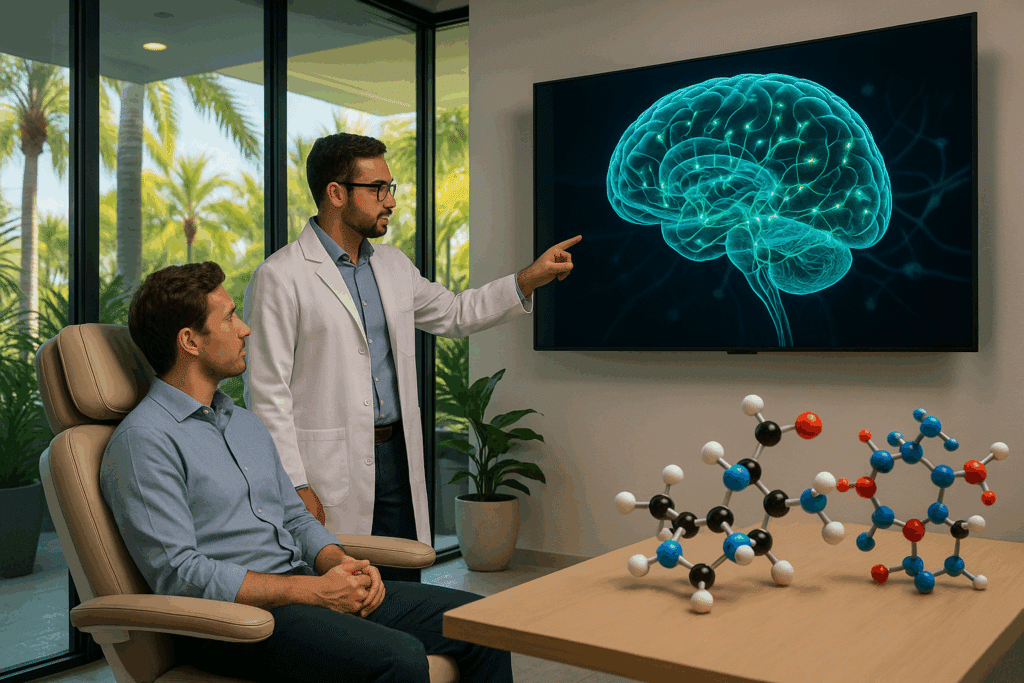
Let’s get real—if you’re struggling with depression, anxiety, PTSD, or chronic pain, you’ve probably heard the buzz around ketamine therapy. But hype aside, how does ketamine therapy work, really? What’s happening in your brain during treatment? And why is Rewired Ketamine’s approach in South Florida setting new standards in neuroplasticity-driven care?
At Rewired Ketamine, we believe patients deserve more than surface-level results. You deserve transformation that’s scientific, measurable, and lasting. That’s why our protocols don’t just ask “what helps,” but dive deep into how ketamine therapy works—at the molecular, neurological, and experiential levels.
Rewiring the Brain: The Scientific Foundation of Ketamine Therapy
To understand how ketamine therapy works, we need to go back to basics. Originally developed as an anesthetic, ketamine has evolved into a cutting-edge treatment for mental health and chronic pain—thanks to its ability to radically shift brain function.
Unlike antidepressants that can take weeks to kick in (if they work at all), ketamine works within hours by targeting the NMDA receptors in your brain. This mechanism rapidly alters glutamate—the brain’s primary excitatory neurotransmitter—catalyzing a domino effect of healing. In other words, how ketamine therapy works is through direct neurochemical intervention, not just masking symptoms.
Deep Dive: The Neuroscience of How Ketamine Therapy Works
Here’s what’s actually happening in your brain:
- NMDA Receptor Antagonism: Ketamine blocks NMDA receptors, decreasing excitotoxicity (which can kill neurons in depression) and resetting the brain’s default mode.
- Glutamate System Modulation: It floods the brain with glutamate, stimulating synaptic plasticity—your brain’s ability to rewire itself.
- BDNF Activation: Ketamine stimulates the release of brain-derived neurotrophic factor (BDNF), which encourages the growth of new neural connections.
- Synaptic Growth: This is where the magic happens. You’re not just feeling better—you’re building a brain that’s structurally different. That’s how ketamine therapy works to heal rather than just help.
Why Rewired Ketamine Works Better
Many clinics offer ketamine. But how ketamine therapy works at Rewired Ketamine is something else entirely. Our unique model amplifies ketamine’s natural neuroplasticity effects through proprietary innovations like:
- Automated Self-Association Training (ASAT): A cognitive-behavioral technology we integrate during your infusion to guide your brain toward healing associations.
- Personalized Dosing Protocols: Not one-size-fits-all. We track real-time biometrics and symptoms to optimize dosage per session.
- IV Vitamin Synergy: We pair ketamine with nutritional IV therapy to enhance neurotransmitter function and brain resilience.
- Peer Specialist Support: Our certified integration specialists, many of whom are trauma survivors themselves, help you process and apply each experience.
This synergy of science and support is how ketamine therapy works best—in a structured, compassionate, and deeply individualized ecosystem.
Comparing Traditional Antidepressants vs. How Ketamine Therapy Works
SSRIs and other antidepressants tweak serotonin levels. But they don’t induce neuroplasticity the way ketamine does. That’s why most take weeks, come with side effects, and often lead to relapse.
By contrast, how ketamine therapy works at Rewired Ketamine is fast, holistic, and durable. You feel better because your brain is literally restructured to function differently. Think of it as upgrading your mental operating system—not patching a glitch.
How Ketamine Therapy Works Across Conditions
Let’s break down how ketamine therapy works for specific diagnoses:
- Depression: Reverses cortical atrophy, improves mood regulation through new neural growth.
- Anxiety: Calms hyperactive amygdala activity, rewires fear circuits.
- PTSD: Allows safe reprocessing of trauma without emotional flooding.
- Chronic Pain: Resets central pain pathways, reducing the brain’s overactive pain perception.
- OCD: Interrupts obsessive loops by modifying neurotransmission and enhancing cognitive flexibility.
The Timeline: How Ketamine Therapy Works Over Time
Patients often ask about the treatment arc. Here’s the breakdown:
- Acute Phase: The first 1–3 infusions rapidly reduce symptoms.
- Consolidation Phase: Neural pathways are strengthened with consistent dosing and integration.
- Maintenance Phase: Ongoing support and periodic infusions help retain and deepen progress.
Each stage reflects how ketamine therapy works in real-time across the brain’s adaptive landscape.
Visualizing the Change: Brain Before & After Ketamine
Neuroimaging studies show exactly how ketamine therapy works to repair depressed, underactive brain regions—especially in the prefrontal cortex. At Rewired Ketamine, we use advanced assessments and imaging tools (when clinically appropriate) to track your transformation, visually and functionally.
Optimizing How Ketamine Therapy Works: Your Role
To get the most from treatment, we guide patients in:
- Pre-treatment prep: Diet, sleep, and intention-setting all affect how ketamine therapy works in your system.
- Integration practices: Journaling, mindfulness, and ASAT help lock in new neural pathways.
- Lifestyle changes: Exercise, nutrition, and therapeutic support boost BDNF and maximize long-term outcomes.
The Rewired Ketamine Difference
Dr. Steven Silverstone and our entire team bring unmatched clinical rigor to the field of psychedelic medicine. From the luxury of our South Florida location to the precision of our IV infusions, how ketamine therapy works here isn’t just science—it’s art and science together.
Ready to see how ketamine therapy works—for you?
Rewired Ketamine is where breakthrough science meets compassionate care. We don’t just offer ketamine—we help you harness how ketamine therapy works to fundamentally reshape your mind, your mood, and your future.
Explore
